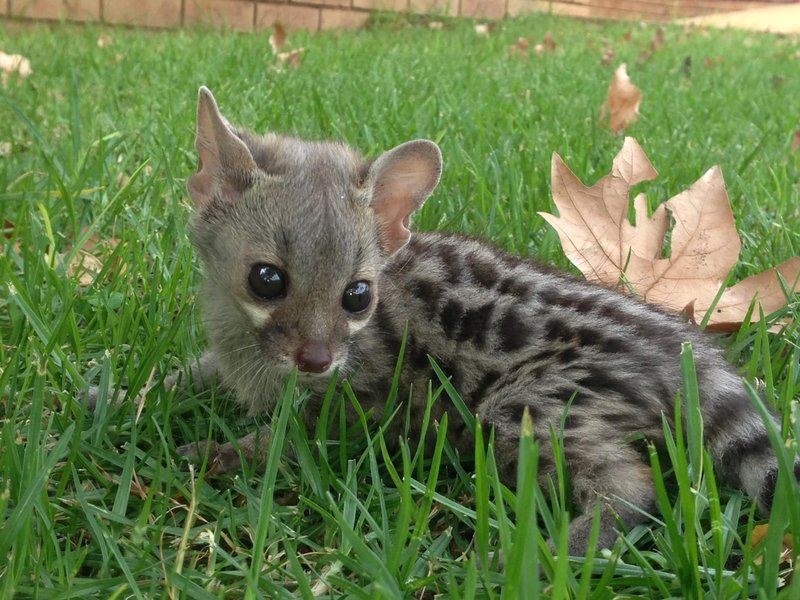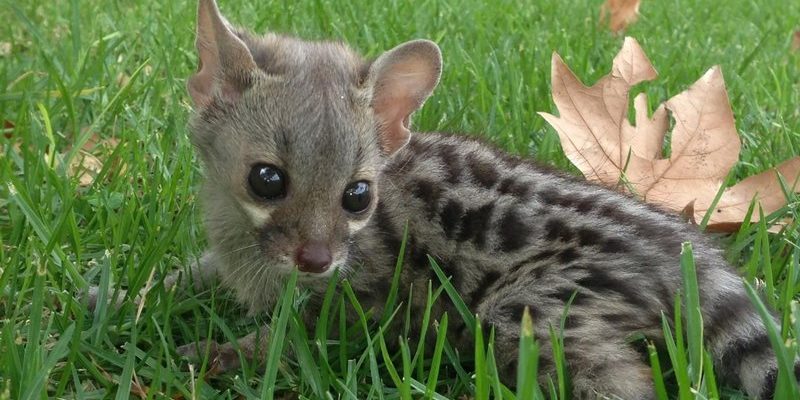
Genets belong to the family Viverridae, which includes other interesting critters like civets and linsangs. They’ve got a sleek body, a long tail, and beautiful spots or stripes that give them a rather exotic appearance. Let’s dive into some fascinating facts about genets that will make you appreciate these unique animals even more.
1. Genets Are Not Cats—But They Sure Look Like Them
It’s easy to confuse a genet with a domestic cat, but they belong to a different family. Genets actually share more similarities with civets than with felines. With their elongated bodies and large, expressive eyes, genets can easily captivate anyone who sees them.
Here’s the thing: despite their cat-like look, genets are more similar to weasels when it comes to their behavior and habitat. A good way to visualize this is to think of them as the cool cousins of cats who decided to live in the trees and explore the wild. You might be wondering how they live in their natural habitat. Genets prefer wooded areas and are mostly nocturnal, coming alive at night to hunt for food and explore.
2. Their Diet Is Quite Diverse
Genets are omnivores, which means they eat a variety of things. If you were to spot one rummaging through the underbrush, you might see it munching on insects, small mammals, birds, and even fruits.
You could say that genets are like nature’s little garbage disposals—they help keep ecosystems balanced by controlling insect and rodent populations. They are also known to hunt at night, using their acute senses to locate food. It’s pretty impressive how they can adapt their diet based on what’s available in the area, just like how you might choose a meal based on what’s in your fridge.
3. Sleek and Agile: Masters of Climbing
One of the most striking features of genets is their climbing ability. With long limbs and a flexible body, they’re born athletes. You wouldn’t catch one lounging around for too long.
In fact, genets are often found in trees, where they can easily escape predators and find food. Imagine a tiny gymnast, nimbly bouncing from branch to branch without breaking a sweat. Their keen sense of balance and agility allows them to move through their environment with grace, making them fascinating to observe in the wild.
4. A Unique Way of Communicating
Genets have a variety of ways to communicate with each other, and it’s not just through vocalizations. They often use scent markings to establish territory and communicate with potential mates.
Think of them as nature’s tiny diplomats, messaging each other about their presence through the scents they leave behind. They have scent glands located on their body, including their wrists and under their tails, which they use to mark their territory. This behavior is crucial, especially when it comes to attracting a mate during the breeding season. It’s like sending a little love letter that says, “Hey, I’m here, and I’m ready to mingle!”
5. Genets and Their Long Tails
Did you know that a genet’s tail can be nearly as long as its body? This long tail isn’t just for show. It plays a vital role in balance, especially when they’re perched on branches or making quick turns while running.
You might think of their tail as a built-in balance beam, helping them navigate the treetops with ease. Plus, their tail is quite expressive—it can be raised or lowered depending on their mood. So next time you come across a genet, pay attention to that tail; it’s giving you important clues about how they’re feeling.
6. Social Creatures at Heart
While you might think of genets as solitary animals, they can also be quite social. They often live in small family groups and can be seen grooming each other, which is a bonding behavior.
Sharing personal space in the animal kingdom might seem rare, but genets have their own way of forming connections. This social aspect is especially important during the breeding season, where they can be found engaging in elaborate courtship displays. It’s fascinating to think about how they balance their independent nature with the occasional need for companionship—kind of like how we enjoy spending time with friends but also cherish our alone time.
7. Unique Reproductive Habits
When it comes to reproduction, genets have some unique traits. They typically breed once a year, with a gestation period of about 75 to 80 days.
Here’s a fun twist: the females can choose when to give birth if they feel conditions aren’t right. This flexibility allows them to ensure the best chances of survival for their young. Once the kits are born, they are quite helpless at first, relying heavily on their mothers for care and protection until they grow more independent. It’s a nurturing side of genets that many people might not know!
8. Their Role in the Ecosystem
Genets play an essential role in their ecosystems. As both predators and prey, they help maintain a balance within the food chain.
In many ways, they serve a double function. By controlling pest populations, they help protect crops and reduce the spread of disease. At the same time, they are also a food source for larger predators. Understanding their role can help us appreciate how interconnected nature really is. It’s a reminder that even the smallest animals can have a big impact.
9. Conservation Status: A Mixed Bag
While genets are not considered endangered, their populations do face threats from habitat loss and hunting.
In some regions, they are hunted for their fur, while in others, they lose their homes due to deforestation. Awareness about their plight is crucial, as every animal plays a part in its habitat. Supporting conservation efforts can help ensure that these fascinating creatures continue to thrive in the wild for generations to come.
10. Keeping Genets as Pets: What You Need to Know
You might be curious whether genets can be kept as pets. While they can be domesticated, they generally require a lot of space and specific care.
Genets are not like traditional pets such as dogs or cats; they have active lifestyles, need stimulation, and might not adapt well to being confined. If someone is considering a genet as a pet, they should be prepared for a unique experience that involves understanding their behavior and needs. It’s a bit like having a pet raccoon—charming and mischievous, but definitely not for everyone!
In conclusion, genets are fascinating creatures with unique traits that make them stand out in the animal kingdom. From their climbing prowess to their social dynamics, there’s so much to appreciate about them. While they may not be household names like other pets, they certainly deserve a spot in the spotlight. By understanding and protecting them, we ensure that their unique stories continue to be told.

